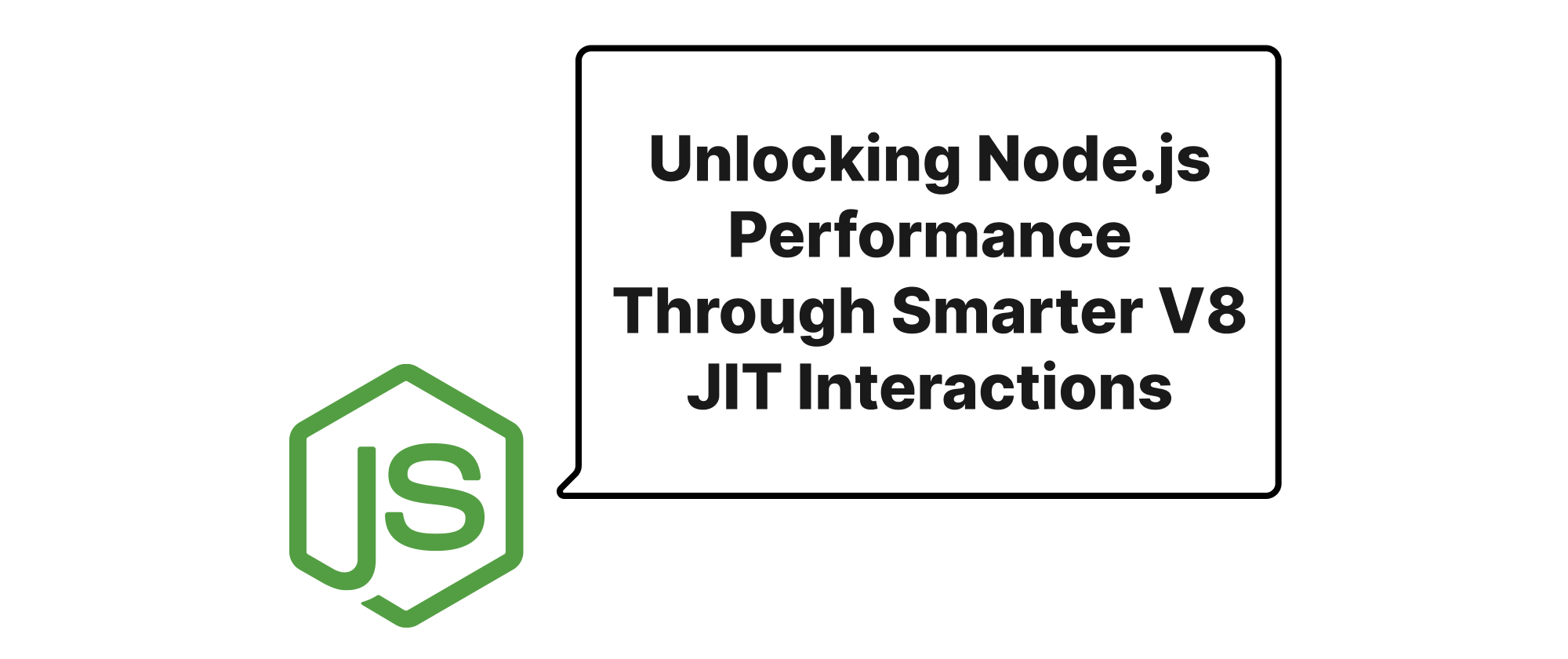Unlocking Node.js Performance Through Smarter V8 JIT Interactions
Grace Collins
Solutions Engineer · Leapcell

Introduction
In the fast-paced world of web development, Node.js has emerged as a cornerstone technology for building scalable and high-performance backend services. Its ability to handle numerous concurrent connections and its JavaScript-everywhere paradigm have made it incredibly popular. However, simply writing functional JavaScript code in Node.js doesn't automatically guarantee optimal performance. Beneath the surface, the V8 JavaScript engine, which powers Node.js, employs a sophisticated Just-In-Time (JIT) compilation strategy to translate your human-readable JavaScript into highly optimized machine code. Many developers, though aware of V8, rarely dive deep into how its JIT compiler operates and, more importantly, how their coding patterns can either help or hinder its optimization efforts. Understanding this invisible dance between your Node.js code and V8's JIT is not merely an academic exercise; it's a practical imperative for unlocking significant performance gains, reducing resource consumption, and building truly robust applications. This article will guide you through the intricacies of V8's JIT compiler and show you how to write Node.js code that better cooperates with it, leading to noticeable performance improvements.
Understanding V8's JIT Compiler and Its Optimization Strategies
Before we delve into specific coding techniques, let's briefly unpack some core concepts related to V8's JIT compiler.
V8 JIT Compiler: At its heart, V8 doesn't directly run JavaScript bytecode. Instead, it compiles JavaScript code into machine code on the fly, just before or during execution. This "Just-In-Time" compilation allows V8 to make dynamic optimization decisions based on runtime profiling information.
Turbofan and Sparkplug: V8 uses a multi-tiered compilation pipeline.
- Sparkplug (formerly Ignition/Liftoff): This is V8's baseline compiler. It quickly generates unoptimized machine code from JavaScript bytecode (generated by Ignition) to get code running fast. The goal here is speed of compilation, not speed of execution.
- Turbofan: This is V8's optimizing compiler. After Sparkplug has executed code for a while, V8 collects profiling data (e.g., types of arguments passed to functions, common return values, property access patterns). If a function becomes "hot" (executed frequently), Turbofan takes over, using this profiling data to generate highly optimized machine code. It can perform aggressive optimizations like inlining, type specialization, and dead-code elimination.
Deoptimization: The Achilles' heel of JIT optimization is dynamic behavior. If the assumptions Turbofan made during optimization (based on profiling data) turn out to be false at runtime (e.g., a function suddenly receives an unexpected type of argument), Turbofan has to "deoptimize." This means discarding the optimized machine code and falling back to the less optimized Sparkplug code, or even recompiling. Deoptimization is expensive and leads to performance cliffs.
Hidden Classes (or Maps): JavaScript is a prototype-based language where objects can be modified dynamically. To make property access efficient, V8 uses "hidden classes" internally. When an object is created, V8 attaches a hidden class to it, which describes its layout in memory (e.g., x is at offset 0, y is at offset 4). If you add or remove properties, V8 creates a new hidden class. Efficient code tends to use objects with consistent hidden classes, allowing V8 to predict memory layouts.
Now, let's explore how to write Node.js code that plays nicely with these V8 mechanisms.
Consistent Object Shapes are Your Friend
One of the most impactful optimizations comes from maintaining consistent object shapes. When V8 encounters objects with the same properties in the same order, it can reuse hidden classes and generate highly optimized code for property access.
Anti-Pattern:
// anti-pattern: inconsistent object shapes function createUser(name, age, hasEmail) { const user = { name, age }; if (hasEmail) { user.email = `${name.toLowerCase()}@example.com`; } return user; } const user1 = createUser('Alice', 30, true); const user2 = createUser('Bob', 25, false); // user2 lacks the 'email' property const user3 = createUser('Charlie', 35, true); // user3 has 'email'
Here, user1 and user3 will have one hidden class, while user2 will have a different one. If createUser is a hot function, this inconsistency forces V8 to generate less specialized code or potentially deoptimize.
Best Practice: Initialize all properties, even if with default/null values.
// best practice: consistent object shapes function createUserOptimized(name, age, hasEmail) { const user = { name: name, age: age, email: null // Always initialize all properties }; if (hasEmail) { user.email = `${name.toLowerCase()}@example.com`; } return user; } const userA = createUserOptimized('Alice', 30, true); const userB = createUserOptimized('Bob', 25, false); // userB's email is null
Both userA and userB will share the same hidden class, allowing V8 to optimize property access much more effectively. This is particularly crucial inside loops or frequently called functions.
Avoid delete on Object Properties
The delete operator modifies an object's shape by removing a property. This forces V8 to invalidate hidden classes and potentially deoptimize code that relies on that object's structure.
Anti-Pattern:
function processData(data) { // ... some operations if (data.tempProperty) { // do something with tempProperty delete data.tempProperty; // Causes hidden class transition } return data; }
Best Practice: Set the property to null or undefined instead of deleting it, or better yet, create a new object without the undesired property.
function processDataOptimized(data) { // ... some operations if (data.tempProperty) { // do something with tempProperty data.tempProperty = null; // Maintains object shape } return data; } // Or for a cleaner approach if the original object doesn't need to be mutated function processDataImmutable(data) { if (data.tempProperty) { const { tempProperty, ...rest } = data; // Creates a new object without tempProperty // do something with tempProperty return rest; } return data; }
Monomorphic vs. Polymorphic Operations
V8 loves monomorphic operations (operations where types consistently stay the same). When a function or operator consistently receives the same types of arguments, or consistently accesses properties at the same offset (due to hidden classes), V8 can specialize and optimize the machine code. Polymorphic operations, where types vary, lead to less optimal or deoptimized code.
Anti-Pattern: Mixing types in operations.
function add(a, b) { return a + b; } // Anti-pattern: different types passed to `add` add(1, 2); // numbers add('hello', 'world'); // strings add(1, '2'); // mixed, forces type conversion at runtime
While add still works, V8 can't specialize add(a, b) for a single type signature if it encounters many.
Best Practice: Try to keep operations type-consistent where performance is critical. If you need mixed types, encapsulate the type-handling logic.
function addNumbers(a, b) { return a + b; // Always numbers } function concatenateStrings(a, b) { return a + b; // Always strings } // Example usage addNumbers(1, 2); concatenateStrings('hello', 'world');
This doesn't mean you should over-engineer every function, but in tight loops or frequently called utility functions, type consistency can yield benefits.
Function Inlining
Turbofan can "inline" small, frequently called functions directly into their caller's code. This eliminates the overhead of a function call (stack frame creation, argument passing, return value handling) and can expose further optimization opportunities.
While you can't directly control inlining, writing small, focused functions that are called frequently often helps V8 recognize them as candidates for inlining. Avoid giant, multi-purpose functions.
// Smaller, focused functions are good candidates for inlining const calculateTax = (amount, rate) => amount * rate; const applyDiscount = (price, discount) => price * (1 - discount); function getTotalPrice(basePrice, taxRate, discountPercentage) { const tax = calculateTax(basePrice, taxRate); const discountedPrice = applyDiscount(basePrice + tax, discountPercentage); return discountedPrice; }
If calculateTax and applyDiscount are called many times, V8 might inline them into getTotalPrice, making getTotalPrice run faster.
Use Fast Properties and Indexed Properties
V8 distinguishes between "fast properties" and "slow properties."
- Fast Properties: Properties directly attached to an object (not inherited) are stored in a fixed array, referenced by the hidden class. Access is very fast.
- Slow Properties: If you repeatedly add and remove properties, or use properties that are not typically present, V8 might switch to a dictionary-based storage for properties, which is slower for lookup.
Similarly, arrays can have "fast elements" (dense, fixed-size, same type) or "slow elements" (sparse, mixed types).
Best Practice:
- Initialize all properties in the constructor or object literal.
- Avoid adding new properties to objects after they've been created, especially in hot code paths.
- For arrays, prefer dense arrays with elements of the same type. Avoid sparse arrays (
arr[1000] = 'value') unless memory is a major constraint and access patterns are sparse. - Use standard array methods (
push,pop,splice) which are highly optimized.
// Fast properties example class Product { constructor(name, price, sku) { this.name = name; this.price = price; this.sku = sku; } } const product = new Product('Laptop', 1200, 'LP-001'); // All properties initialized in constructor // Fast elements example const numbers = [1, 2, 3, 4, 5]; // Dense array of numbers numbers.push(6); // Optimized array push // Anti-pattern: sparse array, mixed types const sparseArray = []; sparseArray[0] = 'first'; sparseArray[100] = 'hundredth'; // Creates a sparse array sparseArray[1] = 2; // Mixed types
Understanding Performance Pitfalls with eval() and with()
eval() and the with statement introduce dynamic scoping and can make it impossible for V8 to predict variable lookups at compile time. This essentially forces V8 to fallback to very unoptimized code paths for the scope in which they are used.
Anti-Pattern:
function calculateExpression(expression) { // eval() makes optimization impossible for this function's scope return eval(expression); }
Best Practice: Avoid eval() and with entirely. If you need dynamic code generation, consider parsing and constructing functions programmatically if absolutely necessary, but this is a complex advanced topic best avoided if possible. For common use cases like parsing JSON or simple math, there are safer and more performant alternatives.
Micro-benchmarking and Profiling
While these guidelines are helpful, the ultimate proof is in the pudding. Always profile your Node.js applications using tools like Node.js's built-in V8 profiler (--prof flag) or external tools like Chrome DevTools (when attaching to a Node.js process) or 0x. Micro-benchmarking specific functions with libraries like benchmark.js can also provide valuable insights into the performance impact of different coding styles. What seems like an intuitive optimization might sometimes not be, and vice-versa, due to the complexity of the JIT compiler.
# Example of running Node.js with profiling node --prof your_app_entry_point.js
This will generate v8.log files, which can then be processed using node --prof-process v8.log to get a human-readable output of where time is being spent.
Conclusion
Mastering Node.js performance often boils down to understanding the underlying V8 engine and writing JavaScript code that assists, rather than impedes, its Just-In-Time compilation process. By consistently using predictable object shapes, avoiding dynamic structural changes like delete, favoring monomorphic operations, writing small functions, and steering clear of dynamic scope modifiers, you can significantly enhance your application's speed. These practices enable V8's Turbofan to generate highly optimized machine code, leading to faster execution and more efficient resource utilization. Ultimately, writing JIT-friendly code is about making your intentions clear to the compiler, allowing it to perform its best magic.


